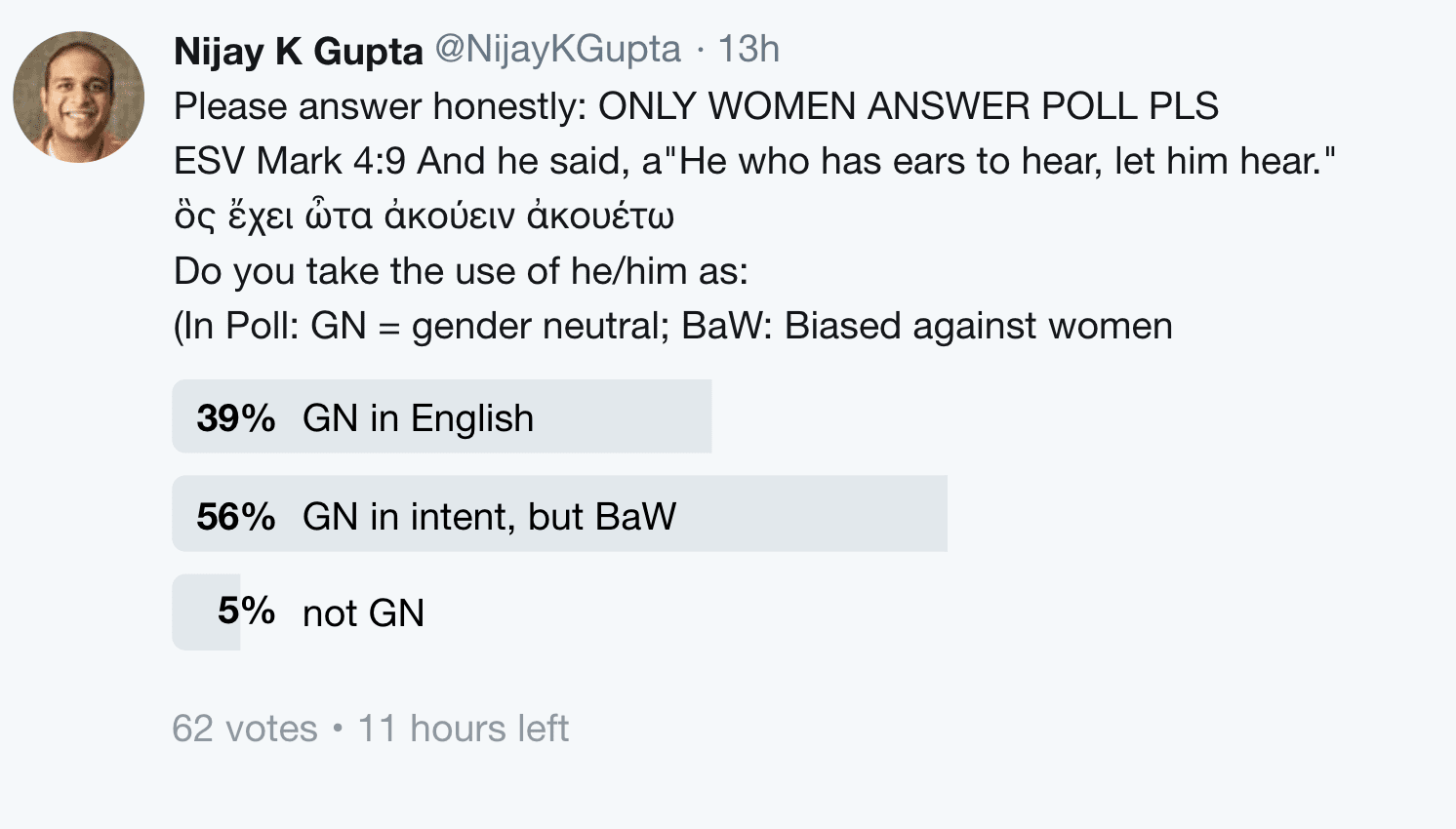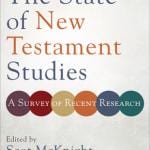Translation Matters: The Generic Use of ἀυτος/autos
This is going to be another post that engages with why Bible translations should be gender inclusive (when the Greek text requires it), and where and why some translations get it wrong. Again, I am going to focus on the ESV because of its popularity.
The following gets a little technical. Sorry, occupational hazard.
What is autos?
This Greek word is a pronoun that can mean he, she, or it. Pronouns refer back to a given noun (in most cases). Its grammatical gender will match its antecedent (what it is referring back to). When it comes to the use of autos in reference to a man or a woman, it will be grammatically masculine in reference to a man, and grammatical feminine in reference to a woman.
The Generic Use of ἀυτος/autos
Sometimes Greek uses autos in a generic way, where it refers to a person (“the one who/whoever”). Technically, the grammatical gender of autos for its generic use is masculine. But it is essential that we understand that this does not require the word to be referring to a male.
The ESV defaults in its use of generic autos to English masculine pronouns
There are hundreds of examples of this in the ESV, but I will demonstrate with just a few.
ESV Luke 9:23 And he said to all, “If anyone would come after me, let him deny himself and take up his cross daily and follow me. (Lk. 9:23 ESV)
Here the ESV renders as “him/his” the occurrences of autos in this verse.
ESV 1 John 3:24 Whoever keeps his commandments abides in God, and God in him. And by this we know that he abides in us, by the Spirit whom he has given us. (1 Jn. 3:24 ESV)
ESV Hebrews 4:10 for whoever has entered God’s rest has also rested from his works as God did from his. (Heb. 4:10 ESV)
ESV Justifies Using Male Pronouns for Generic Autos
The simplistic statement (“this is consistent with similar usage in the original languages”) represents a failure to understand autos. And I think I can prove it.
From my own study of autos, I strongly believe there is a generic use of autos for which we do not have a singular pronoun (generic) version in English. In English, we have to use he/she/it. We don’t have a gender neutral pronoun for humans (“he/she”). I think it is clear that in Greek, while autos is technically masculine, Greek readers would know that in its generic usage the gender is canceled out by context.
How do I know this?
The Non-Male Use of Generic Autos
There is at least one case in the Greek Bible, where generic autos is used when the speaker is directly speaking to a woman. In that case, it would be unfathomable that the speaker would be trying to convince the listener of something, all the while excluding them from the statement.
John 4:14: Jesus Speaking to the Samaritan Woman
John 4:14 but whoever drinks of the water that I will give him will never be thirsty again. The water that I will give him will become in him a spring of water welling up to eternal life.” (Jn. 4:14 ESV)ὃς δ᾽ ἂν πίῃ ἐκ τοῦ ὕδατος οὗ ἐγὼ δώσω αὐτῷ, οὐ μὴ διψήσει εἰς τὸν αἰῶνα, ἀλλὰ τὸ ὕδωρ ὃ δώσω αὐτῷ γενήσεται ἐν αὐτῷ πηγὴ ὕδατος ἁλλομένου εἰς ζωὴν αἰώνιον. (Jn. 4:14 BGT)
Immediately the woman responds: “Sir, give me this water” (4:15). She readily interprets this as a statement made in relation to her. In such cases, it makes far more sense to translate this in a gender neutral way, rather than presume it must mean “him” because of a rigid view of grammatic gender.
We have a similar situation with John 11:25. This one does not contain autos, but it does use generic grammatical masculine language in Greek (“whoever believes”; ὁ πιστεύων), but it is speech directed at a woman (Martha).
ESV John 11:25 Jesus said to her, “I am the resurrection and the life. Whoever believes in me, though he die, yet shall he live, (Jn. 11:25 ESV)εἶπεν αὐτῇ ὁ Ἰησοῦς· ἐγώ εἰμι ἡ ἀνάστασις καὶ ἡ ζωή· ὁ πιστεύων εἰς ἐμὲ κἂν ἀποθάνῃ ζήσεται (Jn. 11:25 BGT)
So what, then? So, it makes little sense to use “his/him/he” in contexts where a generic pronoun/article includes or might include women. The ESV is not being “essentially literal” on these occasions. More accurately, they are operating with a rigid and limited understanding of grammatical gender and the delicacy of taking context into consideration for generic statements.
Most modern translations try to use gender neutral language for generic statements in the Greek Bible. Often that includes changing the statement to fit the word “they/them/their” in English.
NIV Revelation 2:7 Whoever has ears, let them hear what the Spirit says to the churches. To the one who is victorious, I will give the right to eat from the tree of life, which is in the paradise of God.ESV Revelation 2:7 He who has an ear, let him hear what the Spirit says to the churches. To the one who conquers I will grant to eat of the tree of life, which is in the paradise of God.’
BGT Revelation 2:7 Ὁ ἔχων οὖς ἀκουσάτω τί τὸ πνεῦμα λέγει ταῖς ἐκκλησίαις. Τῷ νικῶντι δώσω αὐτῷ φαγεῖν ἐκ τοῦ ξύλου τῆς ζωῆς, ὅ ἐστιν ἐν τῷ παραδείσῳ τοῦ θεοῦ. (Rev. 2:7 BGT)
Notice how the NIV tries to use “they” to replace a masculine pronoun. ESV advocates often argue that this moves away from a literal translation. My response would be that “he” obscures the Greek text as well, so you have to choose your poison. Do you move to “they” as a concession, or do you reinforce androcentricity (male-centered reading) as a concession? Again, I feel the need to point out the ESV oversight committee is all men. It strikes me as grossly irresponsible to make this kind of decision without oversight input from women translators and scholars. After all, more than 50% of Bible readers are women.
The goal of a good translation is not literal word-for-word translation: languages are different, they have different constructs and structures (For example, the Greek particle ἂν is untranslatable). The goal is faithfulness to the original text. In many cases, faithfulness is trying to bring the Greek word into English with as close alignment as can be acquired.
Summary and Implications of My Argument about αὐτος/autos
The ESV assumes that translating the generic use of autos as “he/his/him” is “literal” translation. My argument is that John 4:14 proves that invalid. John 4:14 proves that Greek speakers/writers/readers/hearers would naturally de-genderize the autos in a mixed gender context. Thus, in all cases where the generic autos is used, the only occasions a masculine pronoun should be used,are in contexts where the translator can be sure the statement does not relate to women in any way whatsoever (e.g., in relation to circumcision).
[UPDATE]
I received a comment to the effect that “he/him/his” is considered “gender neutral” by the ESV. I took this into consideration as I wrote this post; I think the ESV committee thinks it is gender inclusive, but I don’t think many readers of the Bible today agree. I have talked to many women today who feel that using he/him/his in generic statements reinforces the marginalization of women and their lives. To me, anything that contributes to that or reinforces it is androcentric (focusing on the lives, experiences, interests of males).
I did a rough and quick poll on Twitter of WOMEN’s thoughts, and I think this comes out clearly (see below). Many women did treat he/him/his as GN but most women feel marginalized in some way by this language. And a small, but important percentage, feel completely left out.














